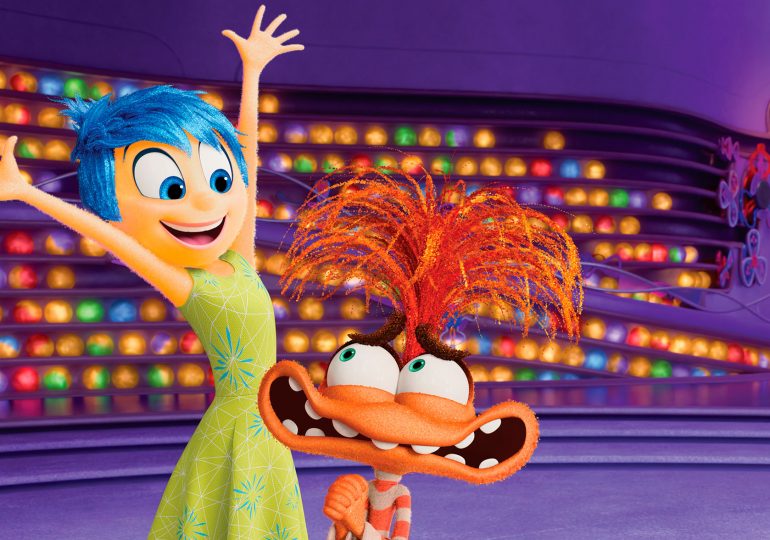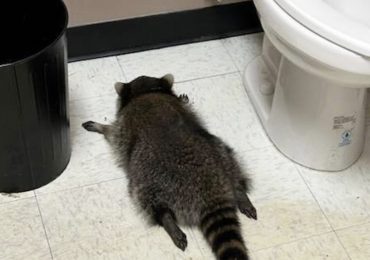Inside Out fans last saw 11-year-old Riley—and Joy, Fear, Sadness, Anger, and Disgust, a.k.a. the five core emotions in the headquarters of her brain—finally accept her feelings in the conclusion to Pixar’s beloved, Oscar-winning 2015 film. In return, she received a brand new “expanded console” control board. On it flashed a red emergency light labeled “Puberty.” ”What’s “Poo-berty?” asks Disgust. “It’s probably not important,” says Joy.
[time-brightcove not-tgx=”true”]
Two Pixar years later—or nine years in real time—Riley is 13 and puberty is proving pretty important indeed in Inside Out 2, a sequel by Dave Holstein and Meg LeFauve out June 14. Inside her now teenage brain, four new emotions are moving in whether she likes it or not: Envy, aquamarine and teeny-tiny in stature with sparking big eyes; Embarrassment, bright red and comically large and always (unsuccessfully) hiding behind his hoodie; French-accented limp noodle Ennui, or as she says, “what you would call, the boredom”; and Anxiety, arguably the most complicated emotion in the bunch, with frazzled hair and arms full of baggage. (And along with these new feelings: a starry new cast of voice actors including Ayo Edibiri, Paul Walter Houser, Adèle Exarchopoulos, and Maya Hawke.)
But don’t be fooled by the twinkles in Envy’s eyes or Anxiety’s raised-right-off-her-head eyebrows; these adorable animated characters—and everything else in the brain-based film—are actually far more complex and neuroscience-rooted than they seem. Even if kids don’t understand it the first time around, the film’s science is real, complicated, and correct. And in order to get it right, Pixar has brought in the professionals.
Dr. Dacher Keltner is a Stanford grad, Berkeley professor, and co-director of the Greater Good Science Centre, with a sweet side gig as part of the Inside Out consulting team, alongside psychologists Paul Ekman and Lisa Damour. Dr. Keltner and Inside Out writer-director Pete Docter, who also wrote Pixar’s Monsters, Inc and Up! and now serves as the company’s chief creative officer, initially bonded over the challenges of parenting preteen daughters before deciding to collaborate. Keltner’s not-so-simple job? Make sure that Inside Out’s creative, innovative story about the voices inside a kid’s brain reflects actual, factual neuroscience. Naturally, it’s not always easy.
TIME called up Keltner at his headquarters at Berkeley College for a lively chat about returning to what is now, in Pixar’s sequel-focused present era, a franchise, how producers picked the first five and now four more core characters, why so-called “bad” emotions can be just as good as the rest and, once she’s old enough to drive a car, what could be next for the inside of Riley’s busy brain.
Read more: Pixar’s Pete Docter: If Inside Out 2 Doesn’t Succeed, We Have to ‘Radically’ Rethink Our Business
TIME: You were a consultant on Inside Out 1 & 2. How did that even happen?
Dr. Dacher Keltner: I’ve taught a human emotion course for 30 years at Berkeley—it’s my pride and joy. In the early days before podcasts, we’d do recordings of the course, and Pete Docter saw one. One day, he called me out of the blue and said, “Hey man, I’m thinking about making a movie about emotions. Come on down.” It went so well that he called me again for Inside Out 2, and here we go again.
Was there any part of you that thought, “A kid’s movie about neuroscience? This isn’t going to work?”
Yes, actually. Even though I come from a family in the arts—my dad is an artist and my mom taught literature—I’m not very good at art. It was very hard for me to imagine how Inside Out would possibly represent the technical complexities of the brain, and I didn’t really. I just do the science and answer their questions. Pete’s first question for me for Inside Out was: How many emotions are there?
So…how many emotions are there?
Twenty, so I initially thought there should be 20 in the film. It was Pete who said, ‘We can’t do that, artistically, so choose five.” This interestingly mirrors emotion science itself, which from about 1975 to 1995 was all about the first five emotions from the first Inside Out: Anger, Fear, Sadness, Disgust, and Joy. That’s the work of Paul Ekman, also a consultant on both films. The second set of emotions, now that Riley’s a teenager, are much more complicated. Teenagers become very self-conscious and very interested in other people’s opinions, so these more social emotions appear like anxiety, envy, and embarrassment, which I’ve personally done a lot of work on.
What did you learn about embarrassment?
I did all this laborious, boring research about whether embarrassment is an emotion. Does it have a distinct facial expression? Yes, it does. Does it have a distinct physiological process? Yes, the blush. What does it do? It makes us aware of other people’s judgments. Why do we have it? Embarrassment is an emotion within a social context that protects the norms that hold people in groups. If you violate a social norm, you blush, and that blush makes people forgive you. It tells people that you’re aware of social norms, you know you made a mistake, and you’re sorry. Embarrassment is painful to experience, but it’s essential to our social lives.
What about envy? Is that also essential?
Envy is a feeling you get when other people have things you want. Maybe this is a promotion at work, or an invitation to a party or attention at the lunch table if you’re a 13-year-old girl. Envy is when someone else has something that you want and you feel that you deserve it too. But there’s new research coming out of Europe that differentiates a malicious sort of envy—maybe you undermine someone’s work or you gossip about them to try to bring them down—with a more benign form of envy where the envious person works harder to earn that reward. That kind of envy can be a really good thing and something that produces great effects. Envy in the film isn’t a villain, and they took great care to draw her that way: She’s adorable and she’s got these big eyes that sparkle.
How do you take a big, scary feeling like anxiety and make it cute and accessible for kids?
We all got very personal, first of all. I had a lot of anxiety for years and panic attacks all the time. But I truly believe the moment you accept your emotion is the same moment it stops being terrifying. It’s when you can say, “Yes, I’m panicking because I’ve got a hard job to do and it’s not going well and those are all good reasons for anxiety.” Then you realize and accept you’re just having a human response, and sure, your heart’s palpating but you’re not going to die. Having a little cartoon character that embodies all those feelings is so good for kids to see. I can’t tell you the number of parents who said, “My little guy loves that Anger character! He looks just like my kid feels.”
Was Anxiety a particularly difficult emotion to portray in the film?
She was, because she’s more complicated than her counterpart, Fear. Fear’s concerned with immediate physical danger—an electrical outlet for a baby, for example—while Anxiety is projecting what might go wrong in the future. That’s a whole lot more to worry about. But her whole point is to look towards uncertainty and imagine potential dangers and work to prevent them. Even Anxiety has a purpose; it shifts our mind towards threats. Now some of these aren’t real, but some are very real. Climate anxiety, for example, is very real, young people feel it all the time, and it’s very important. It’s part of the challenge of development, but that doesn’t make it any easier for 13-year-olds.
The last of the new characters, Ennui, seems kind of obscure, no? How’d she make the cut?
Ennui is going to be a favorite of parents, I think. There are certain emotions that teenagers are great at that drive parents crazy. The eye rolls, the attitude, the utter contempt—that’s Ennui, or boredom in French. I made a pitch for indignation, by the way, which I think would have been great too. Teenagers are so great at it and they’re the ones who are going to change the world. Boredom’s useful too though, because it’s when you disengage from everything else that you can engage in creativity. Boredom tells you when you should do something different. Boredom teaches you what matters to you.
If Inside Out 3 is in our future, what emotions do you want to see next?
If Riley’s 15 or 16, oh man, that’s serious. She’d be moving out of her peer group and into society, hopefully to do something good. So I’d bring in the moral emotions, Indignation of course, but also Awe, Desire, and Compassion. I’ve taught young women for 33 years and can tell you they are so, so hard on themselves. They’re hard on their emotional lives, like, I shouldn’t feel this or I’m bad for feeling that way. That’s just not true. As long as you’re not hurting people, I tend to think all emotions are good. That’s the whole point of this film.
Leave a comment








